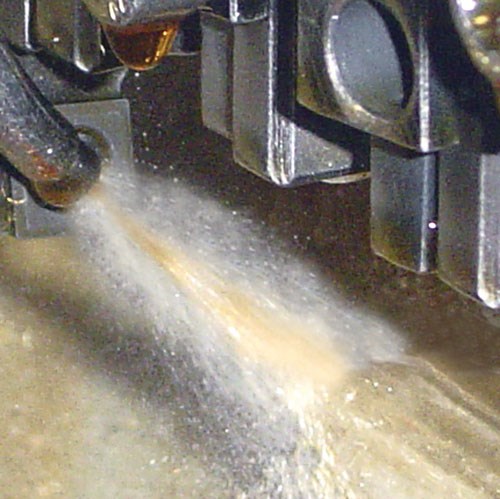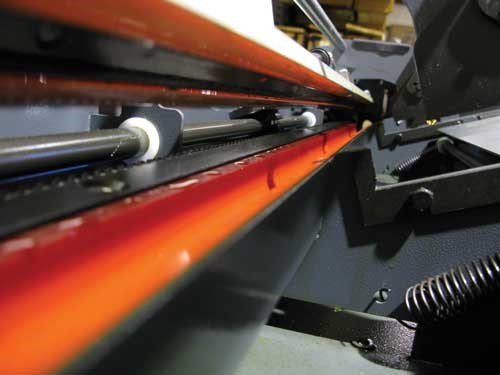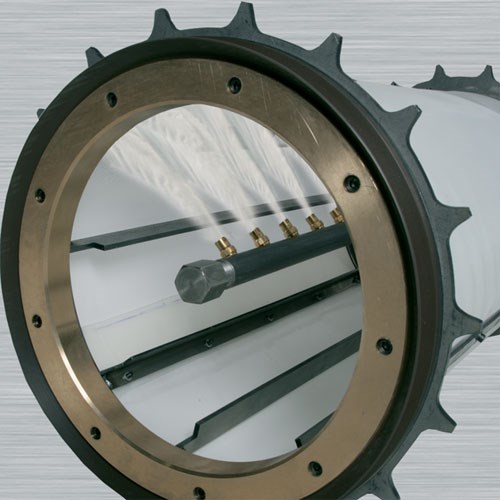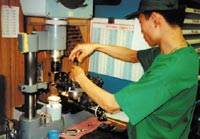Successful Untended Operation
Machine tool accessories can make or break untended operation.
For many machine shops, being both competitive and profitable means reducing labor costs on every part made. So the idea of setting up a turning machine or machining center at closing time and letting it crank out parts overnight with zero payroll expense is a very seductive scenario. In fact, many shops have found a keen competitive edge with untended operation. Others have not been so successful. Why are there different outcomes?
One explanation is that the procedure is a bit more complex than many believe. You can’t simply attach a bar feeder to a turning machine, fill the magazine with barstock and walk away. Successful untended operation requires that the shop consider every aspect of the machining process to ensure that the operation runs smoothly. After all, if anything goes wrong when there is no one on site to correct the problem, production either comes to a halt or, worse, creates more scrap than parts.
This kind of catastrophe can be avoided by carefully examining all aspects of the manufacturing process and then making sure the right equipment is in place. Assuming that the turning machine or machining center is well suited to the process, other concerns include the type of bar feeding and support systems, chip removal devices, coolant management systems and even the cutting tools. Here are some thoughts on each of these.
Cutting, Drilling And Other Tools
Although it may seem obvious, untended operation will fail to deliver the expected results if the cutting, drilling, tapping, milling or other tools are not properly matched to the material and the nature of the operation. We all know that tool wear depends on the hardness of the material machined and the number of operations performed. Determining how many parts can run overnight without a tool change should be a simple equation. But what about other factors that impact tool wear?
For example, at today’s high spindle speeds, a normal coolant wash may not dissipate sufficient heat to keep the cutting tool at optimum operating temperatures or successfully keep chips out of the cutting area, thus accelerating tool wear. In a drilling process, extremely hard materials may create stringy chips that pack themselves into the drill flutes, causing premature wear or even drill breakage.
Of course, there is the option of doing the math to determine how many parts to make under these conditions, or ensuring longer untended runs, extending tool life and protecting product quality by equipping machines with a properly installed high-pressure coolant scheme.
These systems direct the coolant stream more precisely and with the correct amount of pressure to dramatically reduce heat in the cut zone. Not only do high-pressure systems reduce tool wear, they also help break up chips and remove them from the cutting area more efficiently, which means the tool is cutting as it should be, instead of fighting its way through scrap.
By taking into consideration the materials, tools and operations to be performed, tool life can be optimized and, therefore, run longer, untended operations without sacrificing product quality.
Oil Mist Collectors
These products are generally considered in terms of worker health and well being. So why be concerned about oil mist collection during untended operation? The simple answer is that, if you are spraying high-pressure coolant in any part of your operation, the fine droplets and increased coolant flow release greater quantities of coolant into the air. If this fluid is not recovered via a multi-filtration oil mist collector, money is lost on lost coolant and the time it takes the day shift to clean up the residue that settles on the work area.
Chip Removal And Coolant Recovery
As with tool wear, the material and types of operations performed during lights-out production have a significant impact on how well chip and coolant handling systems will function without operator intervention. Putting it another way, these facts will help shops decide what kind of chip conveyor and coolant management system is required for successful untended operation. Here is a list of questions to ask:
Will the chip conveyor be moving mixed materials or will it be dedicated to one specific type of material?
What is the size and configuration of the material?
Is the process creating fine chips, or are the chips coarse or stringy?
If you are performing multiple operations, will you produce a mix of different types of chips?
The answers to these questions affect the ability of the conveyor to move the chips to the disposal bin without clogging and backing up, and may impact the coolant recovery system. For example, the most common chip conveyor is a simple, hinge belt system that works fine in basic cutting applications and with many materials. However, when performing multiple operations such as drilling or milling that produce very fine chips mixed with coarse and/or stringy chips, the coolant can flush the fines through the drain openings in the conveyor and enter the pumps that recirculate the coolant. This can clog the pumps, thereby reducing the flow of coolant to the work area or shutting them down altogether.
In this case, the answer may be to install a chip conveyor that also incorporates a coolant filtering system. The LNS Microfine series, for example, has a sealed filtration drum that removes fines and filters the coolant to 50 microns before it reaches the re-circulating pump. The fines are then flushed out of the steel filters and disposed of. This type of filtering conveyor is especially useful for Swiss turning, multi-axis turning and both vertical and horizontal machining centers.
Bar Feeding
In any untended operation using barstock, having the right bar feed system is essential for success. The key, again, is to consider the type of material, operations to be performed and the number of parts to be made. In high-volume production, for example, the bar feed must have the capacity to hold and load enough barstock to achieve the production quota. But the most important considerations involve the bar feeder’s ability to allow the machine tool to operate at peak spindle speeds, eliminate vibrations that can cause excessive tool wear and quality problems, precisely and continuously load barstock to prevent crashes, and protect the surface finish of chromed or other delicate materials.
The first two considerations go hand-in-hand. A 12- or 6-foot length of barstock is seldom perfectly straight, so when it begins to rotate, it tends to lobe. This action, in turn, creates vibrations that transfer to the cutting area and impact the precision of the cut. It may be possible to compensate somewhat by reducing the spindle speed, but doing so increases the cycle time, which impacts productivity.
Fortunately, advanced bar feed technology can eliminate this problem. It all comes down to properly supporting the barstock throughout the entire process. The hydrodynamic principal that LNS introduced more than 25 years ago is still the industry standard for many applications. By injecting oil into the rear of the bar feed, a fluid bath is created around the barstock. Once the bar starts spinning, the oil creates outward pressure between the OD of the bar and the ID of the guiding channel. In effect, this action creates an oil buffer between the barstock and the guiding channel that keeps the bar from oscillating as it turns. As spindle speed increases, the lifting force of the oil becomes even greater, thus maintaining bar support throughout the process.
In some cases involving larger diameter bars and more precise machining specifications, a bar feed using the hydrostatic principal may be the right choice. The hydrostatic concept involves pressurizing hydrostatic bearings with oil before the barstock begins to rotate, creating tighter tolerances between the barstock OD and the guiding tube ID. The downside of the hydrostatic approach is that to achieve the desired effect, the gap between the barstock and the guiding channel must be kept within tighter tolerances, thereby narrowing the range of barstock that can be run without a change-over.
Another important bar feed issue is how well the barstock is supported between the bar feed and the machine tool collet. Lack of support in this area can allow vibration to impact the precision of the machining operation and even create a safety hazard if the eccentric motion causes the bar to pull out of the collet chuck. In Swiss applications, using what LNS calls a “Swiss Safety Connection” (a tube that connects the bar feed to the machine collet) solves this problem.
Newer sliding headstock turning machines that provide faster feed rates and higher spindle speeds present additional challenges to bar feeding, especially in applications involving small-diameter precision parts or long shafts. The issue is how to consistently and accurately position the barstock to take advantage of the higher speeds and feeds without damaging the part or the turning machine.
For these instances, LNS developed a patented intelligent synchronization system that maintains constant, dynamic barstock position control throughout the machining cycle. The system links a controller, a series of sensors and servodrive motors that are directly connected to the headstock to eliminate any lapse in forward and reverse acceleration. By continuously monitoring the sliding headstock and bar feeding movements, the system literally anticipates headstock motion. This allows for precise synchronization of the pusher and the lathe headstock. By virtually eliminating barstock misalignment, the system allows the turning machine to operate at peak efficiency.
Putting It All Together
With all of these factors to consider, you may wonder if untended operation is right for you. Those that have carefully thought through the process and tracked their results report to LNS that the advantages far outweigh the initial investment. This is particularly true when working with a supplier like LNS that has the ability to help analyze the requirements and the breadth of products necessary to provide the right bar feeders, chip conveyors, coolant management systems and oil mist collectors for a specific operation.
Related Content
Bar Feeder Offers Simple, Fast, Silent Automation
PMTS 2023: Bucci Industries’ Next 25 bar feeder offers high rotational speeds (more than 10,000 rpm) and fast, unattended bar changes with high indexing and silent performance.
Read MoreBar Feeder for Sliding Headstock Lathes Enables Higher RPMs
PMTS 2023: The LNS GT 342 automatic magazine bar feeder is designed to enable fast and easy diameter changeovers and improved productivity.
Read MoreRead Next
Lights-Out Machining Boosts Turning Capacity
A Colchester Tornado A50 CNC lathe, equipped with a bar feed, Renishaw probing, tool monitoring, pickoff unit, swarf conveyor and production-scheduling software, is providing lights-out production capability for Altex Engineering, a (Calne, Wiltshire) U.K. precision subcontractor that specializes in turning and milling in addition to sheet metal fabrication using laser cutting, punch press and folding equipment. With the new CNC lathe, Altex has increased productivity by more than 50 percent on a range of turned components, some 80 percent of which are now completely machined in a single setup.
Read MoreFor Unattended Machining, Attend To Pre-Process
Efficient use of labor is a primary goal of unattended machining. To successfully reduce process intervention, all of the manufacturing disciplines must participate. Accomplishing this requires detailed pre-process planning, which is the key to optimizing machine, material and manpower resources.
Read MoreDo You Have Single Points of Failure?
Plans need to be in place before a catastrophic event occurs.
Read More












.jpg;maxWidth=300;quality=90)











